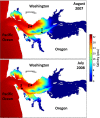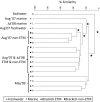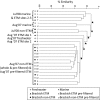Factors affecting the bacterial community composition and heterotrophic production of Columbia River estuarine turbidity maxima
- PMID: 28782284
- PMCID: PMC5727365
- DOI: 10.1002/mbo3.522
Factors affecting the bacterial community composition and heterotrophic production of Columbia River estuarine turbidity maxima
Abstract
Estuarine turbidity maxima (ETM) function as hotspots of microbial activity and diversity in estuaries, yet, little is known about the temporal and spatial variability in ETM bacterial community composition. To determine which environmental factors affect ETM bacterial populations in the Columbia River estuary, we analyzed ETM bacterial community composition (Sanger sequencing and amplicon pyrosequencing of 16S rRNA gene) and bulk heterotrophic production (3 H-leucine incorporation rates). We collected water 20 times to cover five ETM events and obtained 42 samples characterized by different salinities, turbidities, seasons, coastal regimes (upwelling vs. downwelling), locations, and particle size. Spring and summer populations were distinct. All May samples had similar bacterial community composition despite having different salinities (1-24 PSU), but summer non-ETM bacteria separated into marine, freshwater, and brackish assemblages. Summer ETM bacterial communities varied depending on coastal upwelling or downwelling conditions and on the sampling site location with respect to tidal intrusion during the previous neap tide. In contrast to ETM, whole (>0.2 μm) and free-living (0.2-3 μm) assemblages of non-ETM waters were similar to each other, indicating that particle-attached (>3 μm) non-ETM bacteria do not develop a distinct community. Brackish water type (ETM or non-ETM) is thus a major factor affecting particle-attached bacterial communities. Heterotrophic production was higher in particle-attached than free-living fractions in all brackish waters collected throughout the water column during the rise to decline of turbidity through an ETM event (i.e., ETM-impacted waters). However, free-living communities showed higher productivity prior to or after an ETM event (i.e., non-ETM-impacted waters). This study has thus found that Columbia River ETM bacterial communities vary based on seasons, salinity, sampling location, and particle size, with the existence of three particle types characterized by different bacterial communities in ETM, ETM-impacted, and non-ETM-impacted brackish waters. Taxonomic analysis suggests that ETM key biological function is to remineralize organic matter.
Keywords: Columbia River estuary; estuarine turbidity maxima; free-living bacteria; particle-attached bacteria.
© 2017 The Authors. MicrobiologyOpen published by John Wiley & Sons Ltd.
Figures




References
-
- Almeida, M. A. , Cunha, M. A. , & Alcântara, F. (2002). Seasonal change in the proportion of bacterial and phytoplankton production along a salinity gradient in a shallow estuary. Hydrobiologia, 475(476), 251–262.
-
- Baptista, A. M. , Seaton, C. , Wilkin, M. , Riseman, S. , Needoba, J. A. , Maier, D. , … Simon, H. M. (2015). Infrastructure for collaborative science and societal applications in the CRE. Frontiers of Earth Science, 9, 659–682. https://doi.org/10.1007/s11707-015-0540-5 - DOI
-
- Bouvier, T. C. , & del Giorgio, P. A. (2002). Compositional changes in free‐living bacterial communities along a salinity gradient in two temperate estuaries. Limnology and Oceanography, 47, 453–470.
-
- Campbell, B. J. , & Kirchman, D. L. (2013). Bacterial diversity, community structure and potential growth rates along an estuarine salinity gradient. International Society for Microbial Ecology Journal, 7, 210–220. https://doi.org/10.1038/ismej.2012.93 - DOI - PMC - PubMed
Publication types
MeSH terms
Substances
LinkOut - more resources
Full Text Sources
Other Literature Sources

